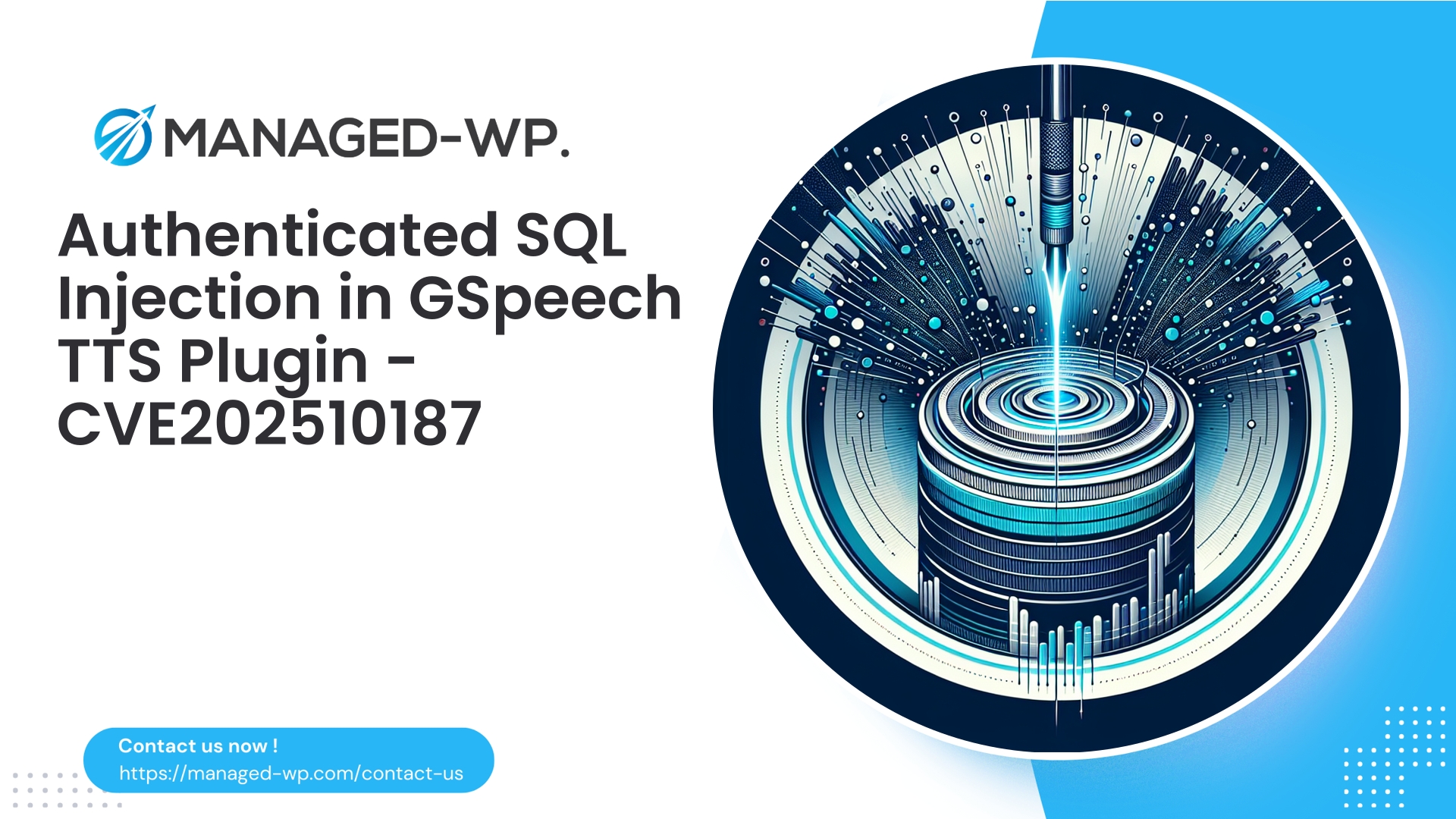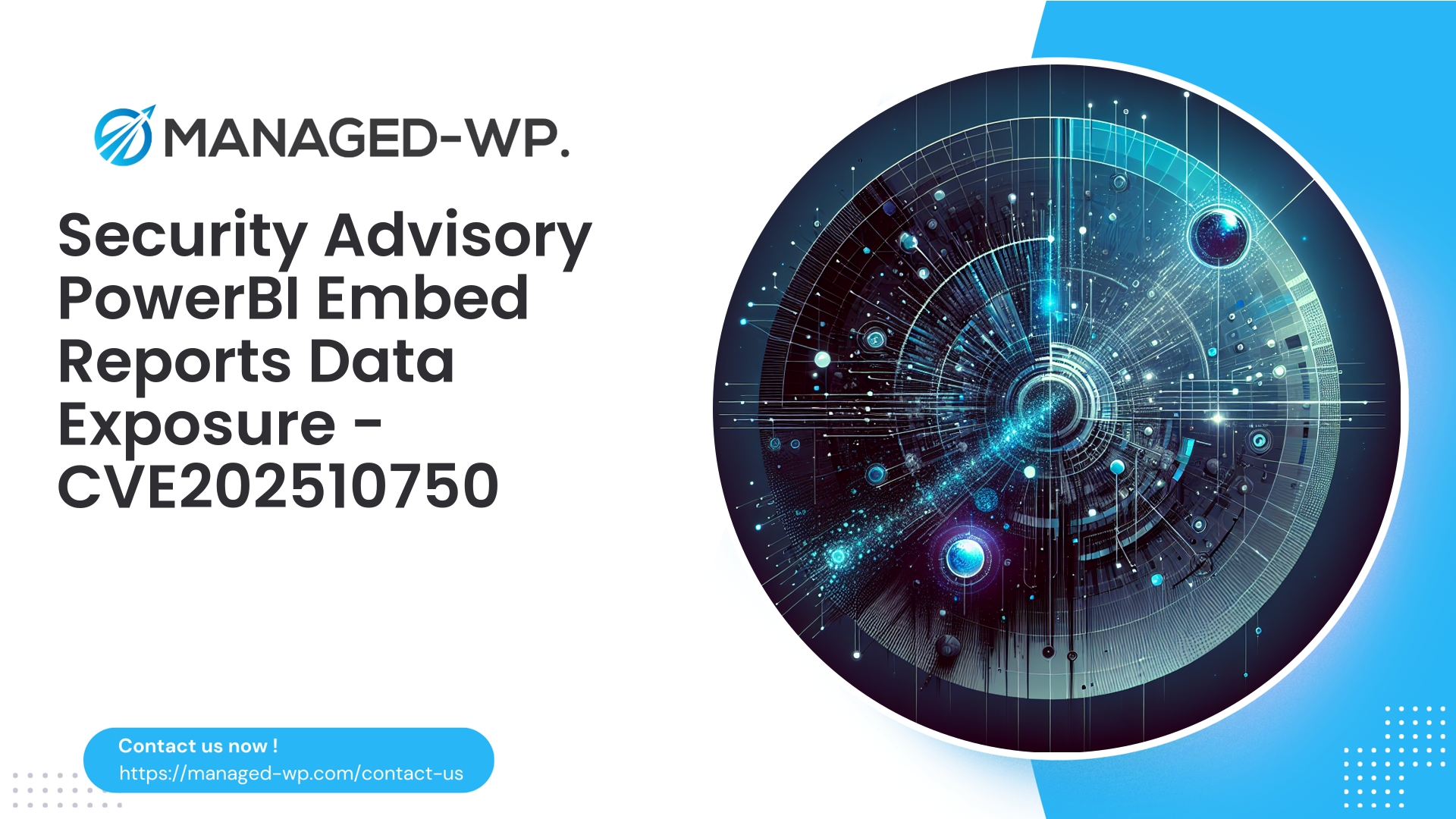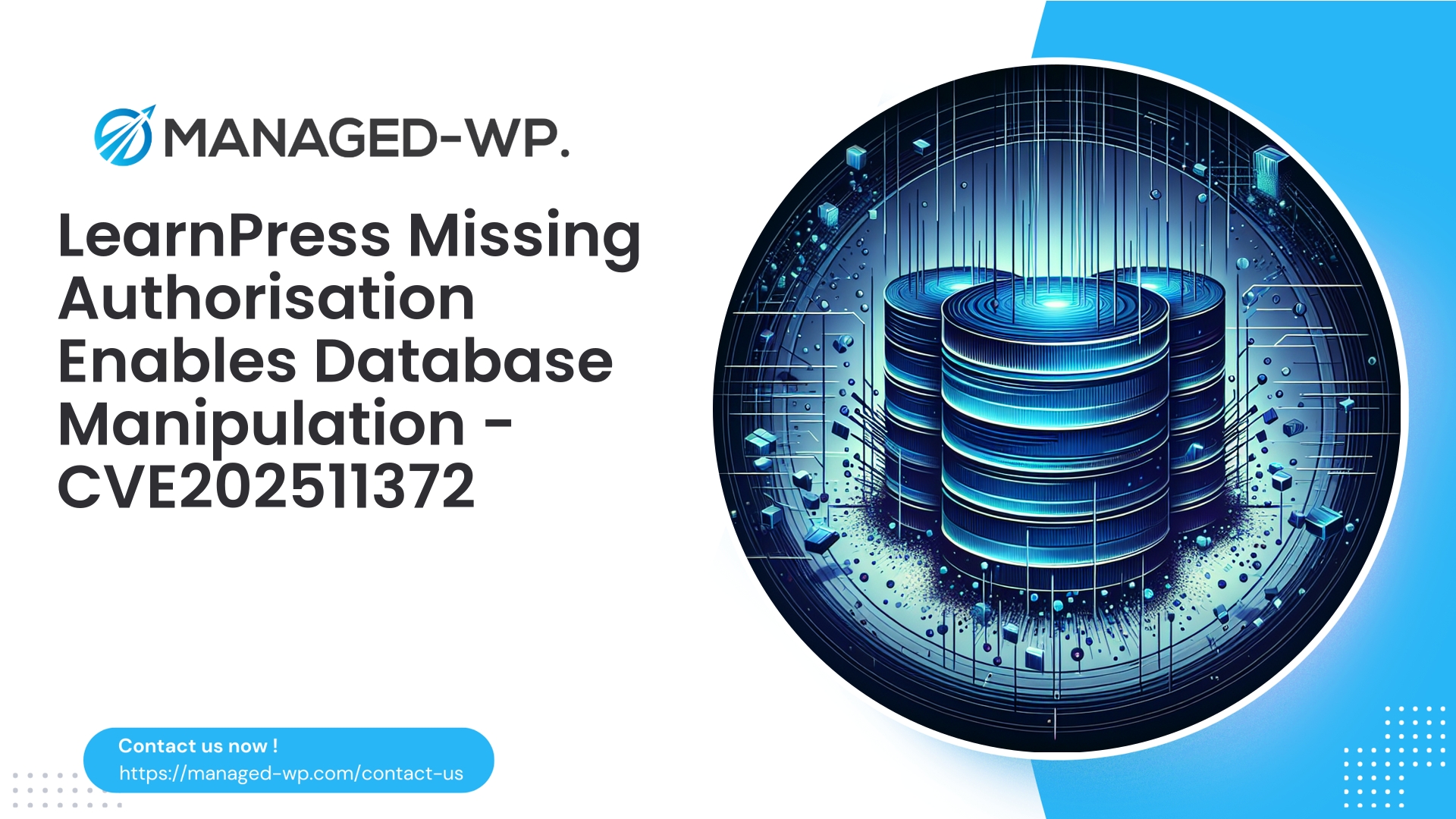| 插件名称 | GSpeech TTS |
|---|---|
| 漏洞类型 | SQL 注入 |
| CVE编号 | CVE-2025-10187 |
| 紧急 | 低的 |
| CVE 发布日期 | 2025-10-18 |
| 源网址 | CVE-2025-10187 |
GSpeech TTS(版本低于或等于 3.17.3)——已认证管理员 SQL 注入漏洞(CVE-2025-10187):网站所有者需采取关键措施
作为一家总部位于美国的 WordPress 安全专家公司,Managed-WP 持续分析并保护 WordPress 环境免受新兴威胁的侵害。近期,GSpeech TTS(WordPress 文本转语音)插件中发现了一个严重的 SQL 注入漏洞 (CVE-2025-10187),该漏洞影响 3.17.3 及更早版本,已在 3.18.0 版本中修复。
虽然利用此漏洞需要经过身份验证的管理员,但拥有管理员权限的攻击者也可以注入恶意 SQL 输入,从而导致数据泄露或未经授权的数据库修改。该漏洞的 CVSS 评分为 7.6,表明其影响较大,但成功利用该漏洞很大程度上取决于特定站点的配置和现有的安全控制措施。
Managed-WP 的这份综合指南将指导您完成以下内容:
- 了解脆弱性及其重要性
- 评估谁可能利用它以及所涉及的实际风险。
- 每个 WordPress 网站所有者都应立即采取以下缓解措施
- 利用Web应用防火墙(WAF)技术和虚拟补丁作为临时防御措施
- 长期安全加固、监控和事件响应最佳实践
- Managed-WP 服务如何在补丁部署期间提供基线保护
我们的目标是为网站所有者、开发人员和托管服务提供商提供清晰、实用的建议(不含营销术语),以便他们能够有效且自信地保护自己的网站。
快速概览
- 漏洞类型: 已认证管理员 SQL 注入
- 受影响的软件: GSpeech TTS – WordPress 文本转语音插件
- 受影响版本: 3.17.3 及更早版本
- 补丁可用: 版本 3.18.0+
- CVE标识符: CVE-2025-10187
- 需要访问权限: 有效的 WordPress 管理员帐户
- 严重程度评级: CVSS 7.6(高,但需要管理)
- 主要风险: 未经授权的数据访问、数据库篡改,可能导致整个网站被攻破。
SQL注入漏洞的机制
这种类型的 SQL 注入发生在 SQL 查询中对不受信任的输入处理不当时。具体来说,GSpeech TTS 插件在其管理界面中接受某些参数,但未进行充分的清理或使用参数化查询。
由于该漏洞只能通过已认证的管理员功能访问,因此利用该漏洞需要现有的管理员权限。然而,鉴于许多安全事件源于凭证窃取、内部威胁或横向移动攻击,此类漏洞会成倍增加攻击的复杂性和影响。
潜在后果包括但不限于:
- 敏感用户数据(包括密码和 API 凭证)泄露
- 未经授权修改或删除内容和网站选项
- 创建或提升用户权限以及隐藏管理员帐户
- 在数据库中插入持久性后门或恶意载荷
- 横向攻击向量导致通过滥用数据路径执行远程代码
开发需求和风险评估
此漏洞需要:
- 拥有 WordPress 管理员帐户(或提升至管理员级别权限)
- 可访问易受攻击插件的管理功能或处理 SQL 查询的参数
鉴于管理员凭证可能通过网络钓鱼、暴力破解、凭证重用或级联漏洞等方式泄露,Managed-WP 建议将此视为严重威胁。攻击者通常会连锁提升权限,因此管理员级别的 SQL 注入漏洞远非纸上谈兵。
立即采取的补救措施(60 分钟内)
如果您的 WordPress 环境包含 GSpeech TTS 插件,请执行以下关键操作:
- 立即更新: 将 GSpeech TTS 升级到 3.18.0 或更高版本——这是唯一彻底的解决方法。
- 如果无法更新: 暂时停用该插件。
笔记: 如果停用导致服务中断,请按如下所述部署 WAF 规则或托管虚拟补丁。 - 审计管理员帐户: 识别并禁用未知或可疑的管理员用户。对所有管理员登录强制执行多因素身份验证 (MFA)。
- 旋转秘密: 更新网站数据库和插件设置中存储的所有 API 密钥、令牌和敏感凭证。
- 审核日志: 检查管理员活动和 Web 服务器日志,查看是否存在异常时段的不规则 POST 请求或未经授权的访问。
- 备份: 在进行任何重大更改之前,请先创建网站文件和数据库的完整备份。
如果发现任何入侵迹象,请按照以下概述的事件处理程序升级您的响应。
潜在利用的检测指南
攻击尝试或成功入侵通常会在网站和服务器日志以及数据库中留下痕迹:
- 意外的变化
wp_options包括异常的计划事件或修改后的自动加载选项 - 创建或修改管理员用户帐户
wp_users和wp_usermeta - 插件特定数据库表或选项中的异常值
- Web服务器访问日志显示来自陌生IP地址或包含可疑载荷的管理面板POST请求
- 数据库查询日志出现异常模式或错误率升高
- 对关键文件进行修改,例如
wp-config.php或包含未经授权的 PHP 文件
以下是一些用于协助调查的数据库查询示例(可根据需要调整前缀):
检查最近创建的管理员用户:
SELECT ID, user_login, user_email, user_registered FROM wp_users WHERE ID IN ( SELECT user_id FROM wp_usermeta WHERE meta_key = 'wp_capabilities' AND meta_value LIKE 'ministrator%' ) ORDER BY user_registered DESC LIMIT 50;
列出最近修改过的选项条目:
SELECT option_name, option_value, option_id FROM wp_options ORDER BY option_id DESC LIMIT 50;
此外,如果您的环境使用活动日志或审计跟踪插件,请检查可疑事件或异常时间前后的管理操作。
在应用更新之前,WAF 和虚拟补丁的作用
在无法立即升级插件的情况下,部署具有虚拟补丁功能的 Web 应用防火墙 (WAF) 可提供至关重要的保护。虚拟补丁可在攻击尝试到达易受攻击的代码之前,在应用层阻止攻击,从而在紧急响应阶段降低攻击面。
Managed-WP 的 WAF 方法的优势包括:
- 在您协调永久性修补工作的同时,快速有效地缓解问题
- 阻止自动扫描工具和手动攻击尝试
- 无论更新计划如何,都能为多个 WordPress 站点提供可扩展的覆盖范围
Managed-WP 的虚拟修补规则专门针对 WordPress 管理端点和易受 SQL 注入攻击的插件参数。
推荐的WAF规则和配置(面向技术团队)
注意:务必在测试环境中测试 WAF 规则,以防止阻止合法的管理活动。
- 阻止管理员 POST 请求中的 SQL 注入模式:
检查是否存在注入向量,例如引号、SQL关键字(OR、UNION)和注释。
ModSecurity 规则示例(概念性):
# 阻止管理员 POST 请求中的 SQL 注入模式 SecRule REQUEST_URI "@rx ^/wp-admin(/|$)|/admin-ajax.php$" \ "phase:2,chain,deny,status:403,log,msg:'在管理员 POST 请求中检测到 SQL 注入'" SecRule REQUEST_METHOD "@streq POST" "chain" SecRule ARGS|ARGS_NAMES|REQUEST_BODY "@rx (?:'|\bOR\b\s*1=1|\bUNION\b|\bSLEEP\(|--|#|/\*)" "t:none"
- 阻止来自可疑用户代理的高熵请求:
阻止针对管理员 URL 的扫描器和机器人。 - 对速率限制敏感的管理端点:
例如,限制插件配置 URI 上每个 IP 每分钟 5 个请求。 - 通过 IP 或 VPN 限制 wp-admin 访问权限:
尽可能强制执行 IP 白名单或仅限 VPN 访问。 - 强制执行严格的内容类型验证:
仅接受管理员 POST 请求中预期的 MIME 类型。 - 禁止在不安全的输入字段中使用 SQL 关键字:
对插件配置输入进行清理,排除已保留的 SQL 关键字。 - 监控并限制 admin-ajax.php 请求:
仅允许已知的、列入白名单的 AJAX 操作,以减少攻击面。 - 实施日志记录和告警:
启用规则触发时的即时通知功能,以便快速响应事件。
重要的: WAF虚拟补丁是对厂商及时补丁的补充,但不能取代厂商及时提供的补丁。
示例:人类可读的托管 WP WAF 规则模板
- 适用于 POST 请求
/wp-admin/*和/wp-admin/admin-ajax.php - 检测请求体中是否包含 SQL 注入标记(例如:
' 或 1=1,联合选择,睡觉()) - 阻止并记录可疑请求;向网站管理员发送通知。
- 允许正常的行政互动,避免不必要的干预。
我们建议先以监控模式运行,以尽量减少误报,然后再强制执行封锁措施。
插件作者和网站开发者的开发最佳实践
为防止出现类似 CVE-2025-10187 的 SQL 注入漏洞,请遵循以下编码原则:
- 使用参数化查询:
利用 WordPress 的功能$wpdb->prepare()所有自定义 SQL 的 API:
global $wpdb; $sql = $wpdb->prepare( "SELECT * FROM {$wpdb->prefix}your_table WHERE name = %s", $name ); $results = $wpdb->get_results( $sql );
- 优先使用 WordPress 核心 API:
使用WP_User_Query,获取选项(),WP_Query等等,如果可行,尽量避免使用原始 SQL。 - 验证并清理输入数据:
申请sanitize_text_field(),intval(),wp_kses_post()视情况而定。
在进行数据库操作之前,务必严格验证数据类型和格式。 - 强制执行能力和随机数检查:
严格核实用户权限当前用户可以()并验证 nonce(验证管理员引用者(),wp_verify_nonce()). - 限制权限:
限制操作权限,仅允许具有最低要求的用户角色和权限的用户执行操作。 - 实现输出转义:
使用esc_html(),esc_attr(), 和esc_url()数据输出位置。 - 集成日志记录和警报:
监控管理员界面中的可疑操作,以便及早发现。
疑似系统入侵事件响应协议
- 隔离该站点:
暂时禁用存在漏洞的插件,限制管理员访问权限,或将网站下线以阻止进一步的恶意活动。 - 保存证据:
在采取破坏性行动之前,请创建网站文件和数据库的全面备份,以便进行取证调查。 - 控制和补救:
删除未经授权的管理员用户,重置密码,并撤销受影响的 API 密钥。
更换或审核wp-config.php轮换使用盐和钥匙。 - 进行全面扫描:
运行恶意软件检测器,检测文件和数据库异常,搜索后门、Web Shell 和可疑的计划任务。 - 恢复到已知良好状态:
如果可能,请在应用插件更新后从干净的备份中恢复。 - 事件后强化:
强制执行多因素身份验证,收紧访问权限,并加强监控。 - 通知利益相关者:
如果敏感数据泄露,请遵守适用的法律法规披露义务。
如果您缺乏事件响应方面的专业知识,请立即聘请合格的网络安全专业人员。
战略强化与长期防御措施
- 保持良好的管理员账户管理习惯——强制使用唯一密码、多因素身份验证,并避免重复使用凭据。
- 尽量减少管理员账户的数量,严格按照需要授予权限。
- 实施分阶段插件更新——在测试环境中验证补丁,但对于关键修复,优先在 1-3 天内及时部署到生产环境。
- 利用文件完整性监控来检测未经授权的代码更改。
- 定期进行异地加密备份,并定期进行恢复演练。
- 集中管理来自 Web 服务器和 WordPress 的日志,以便进行异常检测。
- 定期对插件和主题进行安全审计和自动扫描。
- 禁用上传目录中的 PHP 执行,以防止出现隐蔽后门。
- 通过定义禁用 WordPress 插件和主题编辑器
禁止文件编辑你的wp-config.php.
监控入侵指标 (IoC)
密切关注这些妥协信号:
- 突然增加管理员级别用户
- WordPress cron 中正在运行新的或意外的计划任务
- 与未知或可疑外部系统的出站网络连接
- 创建或修改包含混淆 PHP 代码(例如 base64、eval、gzinflate)的文件
- 管理员端点发出意外的数据库查询
尽可能使用日志记录和监控工具自动发出这些事件的警报。
单站点管理员快速调查清单
- 请将 GSpeech TTS 更新至 3.18.0 版本,或暂时停用直至可以更新。
- 更改所有管理员密码并强制执行双因素身份验证。
- 审查
wp_users和wp_usermeta用于存放意外管理员帐户的表格。 - 扫描文件系统,查找最近添加或修改的文件:
查找 /var/www/html/wp-content -type f -mtime -7 - 在数据库中搜索可疑代码片段,例如:
评估(,base64解码, 或者gzinflate(. - 检查 Web 服务器日志,找出在异常时间发生的管理区域 POST 请求。
- 轮换存储在设置或选项中的所有 API 密钥或令牌的凭据。
- 确认误报率较低后,加强 WAF 规则并从监控模式过渡到阻止模式。
为什么必须认真对待仅限管理员权限的漏洞
有些人可能低估了需要管理员权限才能发现的漏洞,但实际上:
- 弱密码和凭证重复使用仍然是普遍存在的问题。
- 攻击者经常结合网络钓鱼、恶意软件或先前的漏洞利用来获取管理员权限。
- 管理员级别的漏洞利用使攻击者能够创建持久后门并获得对网站的完全控制权。
Managed-WP 强烈建议将所有管理员限制的漏洞都视为最高优先级,尤其是在无法保证帐户安全性的情况下。
Managed-WP Essential Protection — 免费计划,即刻防御
保护您的 WordPress 网站并不一定需要花费巨资。Managed-WP 提供免费的基础套餐,通过以下方式提供针对 CVE-2025-10187 等漏洞的重要保护:
- 托管防火墙和主动式 Web 应用防火墙 (WAF)
- 无限带宽和持续安全更新
- 开箱即用,即可缓解 OWASP Top 10 网络风险
当您的需求不断增长时,我们的付费套餐可提供自动恶意软件清除、IP黑名单/白名单和高级虚拟补丁等增强功能。立即开始您的基础防护:
https://my.wp-firewall.com/buy/wp-firewall-free-plan/
总结性建议:立即、短期和长期
24小时内:
- 将 GSpeech TTS 插件更新至 3.18.0 版本或将其停用。
- 轮换所有管理员凭据并强制执行强大的多因素身份验证。
- 如果补丁程序延迟安装,则部署针对 SQL 注入模式的 WAF 规则。
1-7天内:
- 进行彻底审计,查找泄露迹象。
- 制作并验证可靠的完整备份,包括恢复程序。
- 通过 IP 白名单和会话管理加强管理访问权限。
持续的长期:
- 保持规范的补丁管理和定期更新。
- 利用WAF进行虚拟修补和持续监控。
- 定期检查已安装的插件,并删除未使用或不受支持的插件。
- 强制执行基于角色的访问控制和最小权限原则。
总结发言
此漏洞凸显了多层防御(而不仅仅是打补丁)的重要性。即使需要管理员身份验证,但泄露的凭证和复杂的攻击链仍会使此类漏洞极易被利用,造成严重危害。
Managed-WP 强烈建议所有 WordPress 网站所有者采用纵深防御策略,结合及时应用补丁、严格的管理规范、主动监控和托管式 WAF 防护。我们的免费防火墙方案旨在为您提供即时的托管防御,让您能够安全地部署补丁。
保持警惕——及时修补漏洞,严格保护管理员访问权限,并将主动检测作为安全态势的核心组成部分。



















